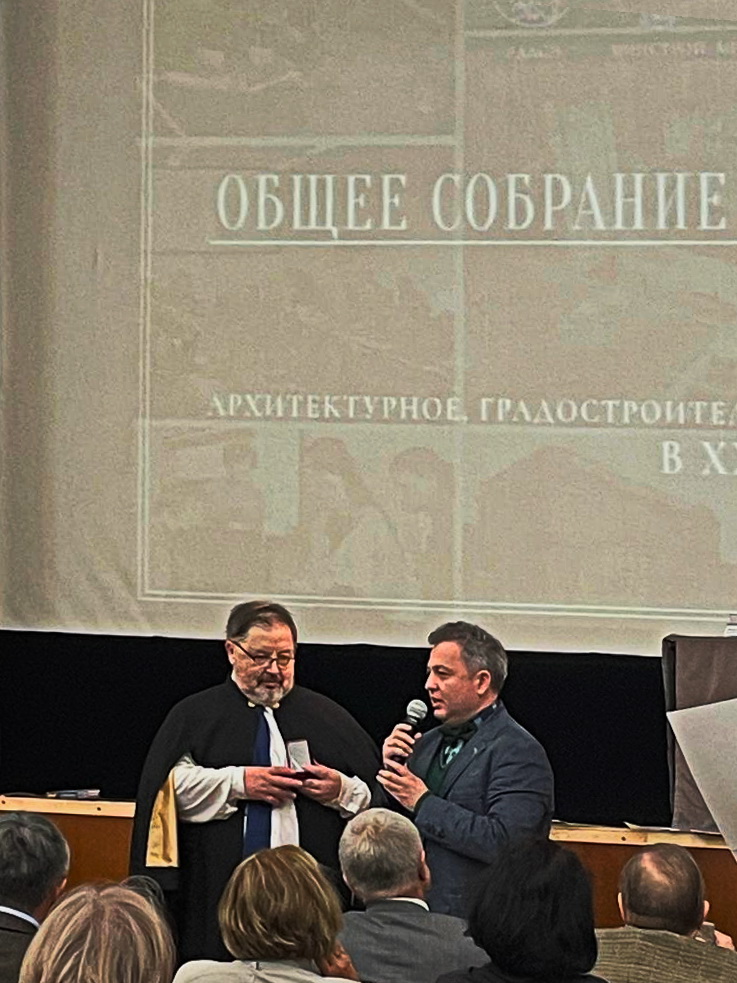 Dmitry Shvidkovsky presents the award to Mikhail Vilensky
Dmitry Shvidkovsky presents the award to Mikhail Vilensky
A graduate of the SPbGASU master's program, Anna Baranova, and her supervisor, Associate Professor at the Department of Urban Planning, Mikhail Vilensky, became laureates of the competition for the Medal of the Russian Academy of Architecture and Construction Sciences named after Ilya Georgievich Lezhava for the best diploma project in the field of urban planning in 2024.
On 25 April, at the general meeting of RAACS members in the Central House of Architects in Moscow, the medal and diplomas were presented to Mikhail Vilensky by RAACS President Dmitry Shvidkovsky. As Mikhail Vilensky reported, this is the first time award is given for a master's thesis project defended in St Petersburg.
Ilya Georgievich Lezhava (1935–2018) is an outstanding Soviet and Russian architect, theorist and practitioner of urban planning, academician of the Russian Academy of Architecture and Construction Sciences, Honored Architect of the Russian Federation, one of the founders of "Paper Architecture" - a direction that includes architectural projects that are unfeasible due to their technical complexity or other reasons. The RAACS Medal named after I. G. Lezhava is awarded annually to one graduate of a Russian architectural university or faculty, a citizen of the Russian Federation, for a final qualifying work for the qualification of "Master" in the field of "Urban Planning".
The medal and diplomas were awarded for the master's thesis "Urban planning organization of the sports infrastructure system in St Petersburg". The project was completed at the SPbGASU Department of Urban Planning. We asked the author of the project and her scientific supervisor to tell us about their work.
Anna Baranova: "For me, architecture is not only design work, but also research work. In modern architectural activity, in my opinion, they are disconnected. For example, in my research on urban planning organization of mass sports infrastructure, to highlight the problem of insufficient sports facilities in St Petersburg, it was necessary to check the existing indicators of provision. It turned out that many factors, such as territorial accessibility, the location of planned facilities and their nature, are simply not taken into account. An analysis of how such objects are designed led to the conclusion about problems in the organization of architectural activity at the legislative level.
Therefore, it is important to reduce the gap between scientific academic activity and architectural practice. They must work together: without understanding the organization and processes of architectural design (practice), science can go into utopia, and design practice without science can lose the common vision of the past, present and future."
Mikhail Vilensky: "The study is devoted to the formation of sports infrastructure in St Petersburg. For a modern person, sports are an integral part of life, but we have outdated social and spatial forms of such infrastructure.
Our work examines the evolution and development of such forms in St Petersburg from their inception to the current state, taking into account the variability of both sports and urban planning forms. The work is based on a large-scale analysis of archival and planometric materials, an assessment of the availability of sports infrastructure and its provision.
For the first time, the development of urban planning regulations in the field of sports infrastructure and their impact on urban planning in the USSR and Russia has been studied. We identified territories in St Petersburg where the provision of sports infrastructure is not only insufficient, but also absent, which leads to complex spatial conflicts when dilemmas arise as to which functions are more important for the city in the context of a deficit of free space. Strategies for the development of various urban territories within the framework of the formation of sports infrastructure have been proposed.
Currently, Anna and I continue to work on this topic – we are developing proposals for improving regional urban development regulations in terms of creating infrastructure for sports.”